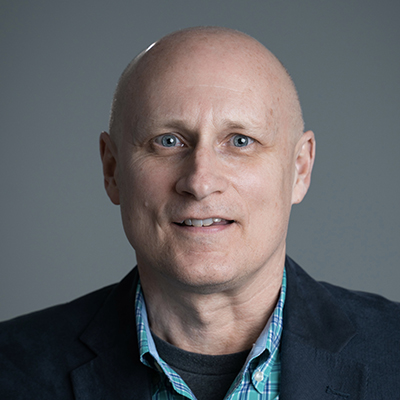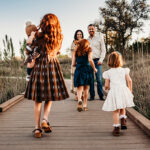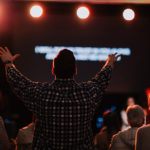
Many with epilepsy are reluctant to attend church because the seizure triggers create an extra barrier, making them feel unwelcome.
By Chris Maxwell
“Wow,” I said.
My one-word-is-enough description was my response to what I noticed as I parked the car.
I stared at vehicles covering the parking lots, people of all ages and nationalities walking in the cool December air, pictures being taken in an ice falling studio, and children ice skating outside. We were there with the crowd to attend a Christmas presentation at a popular church.
As my family and I enjoyed hot chocolate and fake snow on our faces, the crowd from the previous service began exiting. Some friends walked in our direction. They told us how much we would love the experience they’d just had. My friend then looked at me said, “You have your sunglasses? You’ll need them.”
I knew what he meant. He knows I’m part of a population often forgotten among the creative, artistic designers for today’s church services and events.
The Christmas event was great. The church succeeded in helping many people in the community feel welcome, be attentive, and hear the gospel story.
But I left wondering: Do today’s congregations, which are so advanced in technology, know about the 1 in 26 people who will battle epilepsy at some time in their lives? Do they know about photosensitive epilepsy? If so, could they add a warning that some theaters and concerts include, notifying audiences of the potential of their lights triggering seizures?
An article from Psychology Today suggests that fluorescent lights have the potential to cause health problems. They can “emit a ‘flicker,’ which can trigger nervous system events like migraines, tics, or seizures in sensitive individuals.”
The Epilepsy Foundation offers information on photosensitive epilepsy. A few quick facts:
- “For about 3% of people with epilepsy, exposure to flashing lights at certain intensities or to certain visual patterns can trigger seizures; this condition is known as photosensitive epilepsy.”
- “The frequency or speed of flashing light that is most likely to cause seizures varies from person to person.”
- “Generally, flashing lights most likely to trigger seizures are between the frequency of 5 to 30 flashes per second (Hertz). The likelihood of such conditions combining to trigger a seizure is small.”
Though those numbers seem small, I would love for church leaders to read comments in social media’s epilepsy groups. Common concerns are related to bright lights in police cars, emergency vehicles, auditoriums, and, yes, in churches.
I counsel many people with epilepsy who are reluctant to attend church anyway because they feel unloved and unwelcome. The seizure triggers and potential harm from the worship environment create an extra barrier.
What if we made changes just to help them know we care? What if staff meetings included conversations about what to do if someone has a seizure? What if we asked a deeper question like these: Why do we feel the need for these lights? If law enforcement officers can turn off police car lights for a girl with epilepsy, what can churches do?
Tiffany Kairos, like me, lives with epilepsy. Cofounder with her husband Chris of The Epilepsy Network (TEN), Tiffany says, “Flashing/flickering lights at a high intensity cause me to feel susceptible to having a seizure in a moment’s time. With fluorescent lighting (CFL bulbs/tubes) – which is becoming the standard lighting—this has caused problems for me where I go to churches. For extended periods of time, this lighting can cause me auras and even complex partial seizures. In our household we only use yellow lighting and when shopping, I wear sunglasses throughout the store.”
Licensed Psychologist Blake Rackley, PsyD, admits that the times and avenues for sharing the gospel have changed but wonders if we are hindering some from hearing the gospel with our presentations.
“Our stages are full, our bands are rocking, and our services seem to fill with energy to engage the crowd,” Rackley says. “We are on our feet clapping and singing praises. With all our lights, sound, drama, and enthusiasm of our risen Savior, we may miss conveying our message to those who suffer from Autism, PTSD, TBIs, and Epilepsy.
“Think for a moment about the mission of your church to reach the lost. We may be unintentionally excluding those who need God’s healing the most. Our lights and sound, while attractive and sexy, are abrasive and many cannot tolerate them.”
Dr. Rackley offers these suggestions for churches seeking true care for those battling epilepsy or other brain disorders:
- Create a sound-proof room where worship is on a screen.
- Have a break out area where a separate room is dedicated to work with simple instruments without all of the lights.
- Lose the mentality that there is an “atmosphere” of worship. Dim house lights, blaring stage lights, strobes, and multiple colored lights do not bring people closer to God. They do not prepare someone’s heart; they set a mood. While this can be important to some, it is excluding others as they leave our places of worship because they feel trapped, confused, scared, and in pain. These people already feel alienated by the difficulties within their minds and physical bodies. They feel even more so when they can’t worship with others because of our presentation.
- Create an alternative service for those who have particular difficulties. (I know this is easier said than done, but we must become all things to all people.)
- Create services that are geared to those with autism or epilepsy so families of those can worship together without fear.
- Consult psychologists and counselors in your area about ways they can help you create a better worship experience for those suffering from psychological/physiological difficulties. It may bridge a gap to those professionals who don’t know Jesus.
“Wow” is a good thing
Through music and equipment and talent and strong biblical messages and humble servants, I enjoy saying, “Wow.” But I also want to say it when I see more practical assistance for people like me when entering auditoriums with our sunglasses or wheelchairs or medications.
Recently, a friend heard my story about living with epilepsy. I spoke about potential triggers, lights, and stress, and about speaking to churches and businesses about becoming more sensitive to our needs. He said, “You’d definitely need sunglasses in our church.”
I am not anti-tech. And I’m not opposed to modern efforts for churches to connect with audiences. My wish is that such churches proclaiming to reach people would offer fitting environments for those of us who struggle with epilepsy or other health issues.
If such seeker-sensitive churches are determined to design receptive atmospheres, I hope they’ll think of those with epilepsy or other special needs rather than what can grab and keep people’s attention.
Yes, I loved the Christmas musical. The quality of sound and drama helped multitudes of people hear the gospel story. I’m glad we went. And I’m also glad a friend greeted me before I entered the auditorium and warned me about the lighting.

Chris Maxwell
Chris Maxwell served 19 years as lead pastor in Orlando, Florida, after five years of youth ministry. He’s now in his 16th year as Campus Pastor and Director of Spiritual Life at Emmanuel College.











